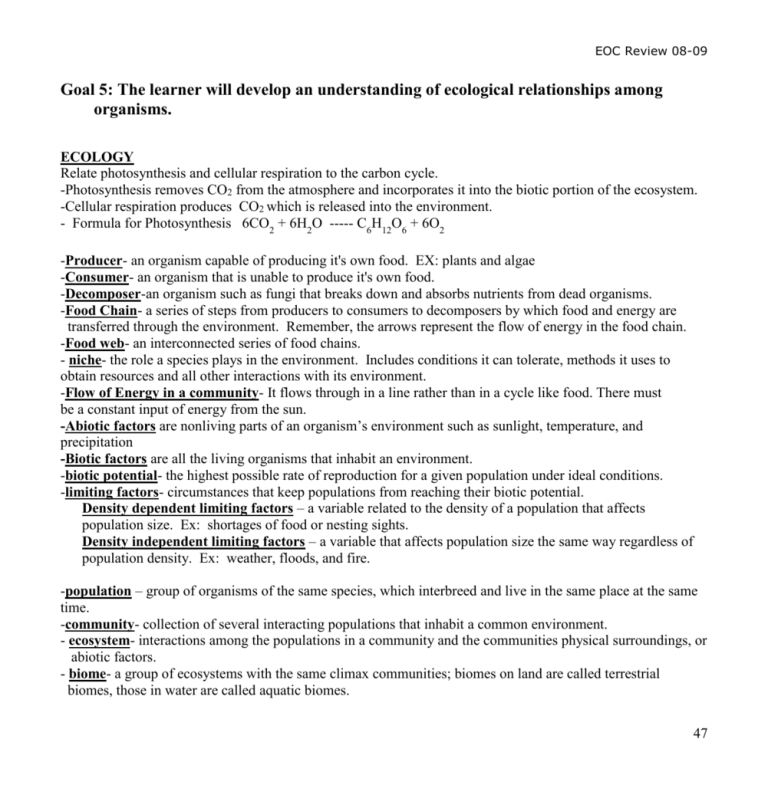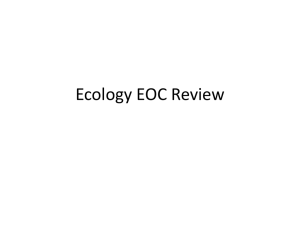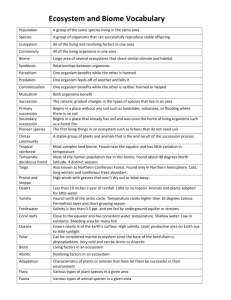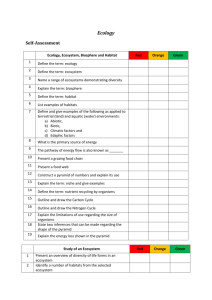The learner will develop an understanding of ecological
advertisement

EOC Review 08-09 Goal 5: The learner will develop an understanding of ecological relationships among organisms. ECOLOGY Relate photosynthesis and cellular respiration to the carbon cycle. -Photosynthesis removes CO2 from the atmosphere and incorporates it into the biotic portion of the ecosystem. -Cellular respiration produces CO2 which is released into the environment. - Formula for Photosynthesis 6CO2 + 6H2O ----- C6H12O6 + 6O2 -Producer- an organism capable of producing it's own food. EX: plants and algae -Consumer- an organism that is unable to produce it's own food. -Decomposer-an organism such as fungi that breaks down and absorbs nutrients from dead organisms. -Food Chain- a series of steps from producers to consumers to decomposers by which food and energy are transferred through the environment. Remember, the arrows represent the flow of energy in the food chain. -Food web- an interconnected series of food chains. - niche- the role a species plays in the environment. Includes conditions it can tolerate, methods it uses to obtain resources and all other interactions with its environment. -Flow of Energy in a community- It flows through in a line rather than in a cycle like food. There must be a constant input of energy from the sun. -Abiotic factors are nonliving parts of an organism’s environment such as sunlight, temperature, and precipitation -Biotic factors are all the living organisms that inhabit an environment. -biotic potential- the highest possible rate of reproduction for a given population under ideal conditions. -limiting factors- circumstances that keep populations from reaching their biotic potential. Density dependent limiting factors – a variable related to the density of a population that affects population size. Ex: shortages of food or nesting sights. Density independent limiting factors – a variable that affects population size the same way regardless of population density. Ex: weather, floods, and fire. -population – group of organisms of the same species, which interbreed and live in the same place at the same time. -community- collection of several interacting populations that inhabit a common environment. - ecosystem- interactions among the populations in a community and the communities physical surroundings, or abiotic factors. - biome- a group of ecosystems with the same climax communities; biomes on land are called terrestrial biomes, those in water are called aquatic biomes. 47 EOC Review 08-09 Abiotic factors such as precipitation and temperature determine the type of plant life there will be in a given area. The plant life in turn determines the kind of animals that will live there. -Recycling of materials in the Environment The Carbon Cycle 48 EOC Review 08-09 The Nitrogen Cycle -symbiosis- living together of two dissimilar organisms for their mutual benefit. Ex: lichens are formed by a symbiotic association between a fungus and an alga. Types of symbiotic relationships ▪ Commensalism- helps one, doesn’t affect the other. Ex: cattle egret and grazing animals ▪ Mutualism- both benefit. Ex: flowers and their pollinators ▪ Parasitism- one benefits while the other is harmed. Ex: dog and heartworm Review predator-prey relationships. 49 EOC Review 08-09 POPULATION GROWTH J curve – exponential growth - Under ideal conditions, (unlimited food supply, no competition for mates, etc.) a population's size would continue to increase indefinitely. This can be shown graphically and resembles the letter J. -S curve – logistic growth -In real populations size cannot continue to increase indefinitely. It will increase until carrying capacity has been reached then it will level off. -carrying capacity -the number of individuals of a population that a given environment can support. 50 EOC Review 08-09 -trophic levels - in an ecosystem, an organism's position in a food chain - for example, herbivores make up the second trophic level and carnivores make up higher trophic levels. Ex: plant ---- mouse-------- snake---------owl------decomposer (producer) (first order (second order (third order consumer) consumer) consumer) FOOD WEB 51 EOC Review 08-09 - pyramid of energy- each wlevel within a pyramid of energy represents the energy available within that trophic level. Each time you move upward in the food chain there is roughly a 90% decrease in the amount of available energy. This means each level contains only about 10% of the energy that was available at the previous level. -pyramid of numbers- a diagram that shows how many individuals an ecosystem can support. -food web -a series of interrelated food chains in an ecosystem. -biomass- total dried weight of all organic matter at different trophic levels. -pyramid of biomass- shows how much living matter an ecosystem can support. Note the difference in the characteristic shape of a terrestrial ecosystem versus an aquatic ecosystem. algal bloom or algae bloom - explosive population increase in algae that occurs when large amounts of phosphates and/or nitrates enter a body of water in the presence of warm temperatures. -Phosphates are found in many detergents. -Phosphates and nitrates are found in fertilizers - Phosphates and nitrates serve as nutrients for algae. With lots of food and warm temperatures the algae population increases extremely rapidly until they have used up all the available nutrients, then they begin to die off very rapidly. As they die they settle to the bottom where they decompose. The decomposition process uses up so much oxygen that there is not enough left for other organisms to carry out cellular respiration. As a result they also begin to die. An entire lake may become stagnant as a result of an algae bloom. 52 EOC Review 08-09 - acid precipitation caused by sulfur dioxide, SO2, which is produced when fossil fuels are burned. Can make lakes and rivers too acidic for organisms to live in, kill trees, and corrode stone. -ozone layer - found at the top of the stratosphere, the layer of ozone gas that absorbs almost all the Ultraviolet radiation that reaches the Earth from the sun. Many scientists think the ozone layer is thinning due to the release of air pollutants known as CFC's (chlorofluorocarbons). CFC's are used as coolants in refrigerators and air conditioners, in the manufacture of styrofoam, and as propellants in aerosol spray cans. -greenhouse effect - results when carbon dioxide traps heat near the Earth's surface; could be producing global warming, which may eventually have a serious effect on climate. - biological magnification- the accumulation and increased concentration of non-biodegradable toxins in the environment as you move up the food chain. Biological magnification of the pesticide DDT caused bald eagles to become endangered. Habitat destruction- is the process in which natural habitat is rendered functionally unable to support the species originally present. In this process, plants and animals which previously used the site are displaced or destroyed, reducing biodiversity. Agriculture is the principle cause of habitat destruction. Other important causes of habitat destruction include mining, logging, trawling and urban sprawl. Habitat destruction is currently ranked as the most important cause of species extinction worldwide. Deforestation- The cutting down and removal of all or most of the trees in a forested area. Deforestation can erode soils, contribute to desertification and the pollution of waterways, and decrease biodiversity through the destruction of habitat. ecological succession - gradual processes by which communities change over time. primary succession - succession that begins in areas where there is no life such as a new volcanic island or an area that has just been exposed due to the movement of a glacier. pioneer stage - the first stage of primary succession, consisting of algae, protists, and cyanobacteria in an aquatic community. Consists of lichens growing on bare rocks in a terrestrial (land) environment. The action of the lichens and their subsequent death and decomposition lead to the formation of soil. -Early stages in succession are characterized by communities with small inhabitants with short life cycles, few different species, simple food chains, and wasted energy. - The community continues to undergo an orderly series of changes until it reaches the final stage of succession. climax community - the final community in ecological succession. The climax community is complex, stable, and tends to remain basically the same unless disturbed by nature or humans. Climax communities are 53 EOC Review 08-09 characterized by larger inhabitants with longer life cycles, many species, complex food webs, and efficient energy use. - Typical succession in a terrestrial biome: rock lichen mosses grasses shrubs trees Quadrant Study- a small portion of the entire area being studied (such as a 1 meter square quadrant) is marked and all the organisms found there are documented. The counts taken in this area are then multiplied to determine the likely number of individuals found in the entire study area. POPULATIONS Review factors influencing birth rates and death rates. Effects of population size, density, and resources used on the environment. - immigration- movement into a population. - emigration- movement out of a population. An introduced species (also known as an exotic species) is an organism that is not native to the place or area where it is considered introduced and instead has been accidently or deliberately transported to the new location by human activity. Introduced species can often be damaging to the ecosystem it is introduced to. 54 EOC Review 08-09 -Estuaries- coastal body of water, partially surrounded by land, in which freshwater and saltwater mix. -Estuaries are considered the most fertile of the aquatic environments and they exhibit a great deal of species diversity. -Salt concentrations in estuaries will vary. Sustainable Practices/Stewardship Sustainability- in recent years, has been expressed as “development that meets the needs of the present without compromising the ability of future generations to meet their own needs”. Sustainable practices include the use of alternative energy sources such as solar and wind power, recycling, and composting. Environmental or ecological stewardship involves using sustainable practices and acting in an environmentally friendly fashion. 55









